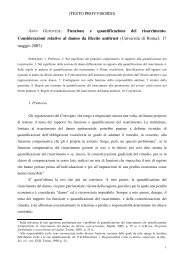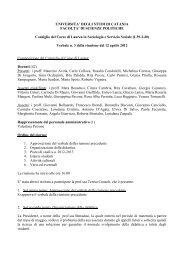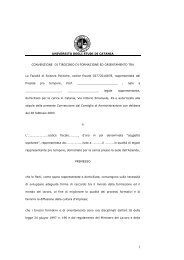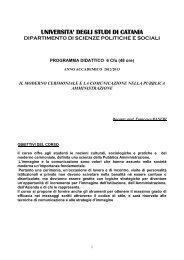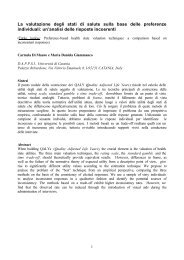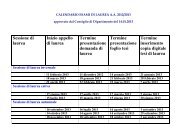The World is Spiky â Th I t ti li ti The Internationalization Process
The World is Spiky â Th I t ti li ti The Internationalization Process
The World is Spiky â Th I t ti li ti The Internationalization Process
Create successful ePaper yourself
Turn your PDF publications into a flip-book with our unique Google optimized e-Paper software.
<strong><strong>Th</strong>e</strong> <strong>World</strong> <strong>is</strong> <strong>Spiky</strong> –<br />
<strong><strong>Th</strong>e</strong> Interna<strong>ti</strong>ona<strong>li</strong>za<strong>ti</strong>on<br />
<strong>ti</strong> <strong>ti</strong><br />
<strong>Process</strong><br />
Torben Pedersen<br />
Professor<br />
Center for Strategic Management and Global<strong>is</strong>a<strong>ti</strong>on<br />
Copenhagen Business School<br />
tp.smg@cbs.dk
A <strong>li</strong>ttle about me…<br />
Educa<strong>ti</strong>on: PhD, Copenhagen Business School, 1994<br />
Guest reseacher: Sweden (Gothenburg), Austria<br />
(Vienna), Finland (Helsinki), New Zeland (Auckland),<br />
USA (Stanford, Rutgers), Austra<strong>li</strong>a (AGSM and<br />
UNSW), Spain (Valencia), Italy (Bocconi and Padova)<br />
Research interests:<br />
• Interna<strong>ti</strong>onal Business Strategy<br />
• Globa<strong>li</strong>za<strong>ti</strong>on, offshoring and outsourcing<br />
• Knowledge management/governance<br />
• Interna<strong>ti</strong>ona<strong>li</strong>za<strong>ti</strong>on process
Structure of seminars<br />
1. Today: <strong><strong>Th</strong>e</strong> world <strong>is</strong> spiky<br />
• Local responsiveness<br />
• Interna<strong>ti</strong>ona<strong>li</strong>za<strong>ti</strong>on <strong>Process</strong><br />
• Case illustra<strong>ti</strong>ons: Ribe and Danfoss<br />
2. Tomorrow: <strong><strong>Th</strong>e</strong> world <strong>is</strong> flat<br />
• Global integra<strong>ti</strong>on<br />
• Offshoring<br />
• Case illustra<strong>ti</strong>ons: Ecco and Vestas
Who cares whether the<br />
world <strong>is</strong> spiky or flat?
Imp<strong>li</strong>ca<strong>ti</strong>ons for business strategy<br />
<strong><strong>Th</strong>e</strong> best way to organize a firm depends<br />
on the nature of the environment to<br />
which the firm must relate<br />
<strong><strong>Th</strong>e</strong> environment <strong>is</strong> the exogenous<br />
variable while strategy and structure<br />
are endogenous ones
Two types of compe<strong>ti</strong><strong>ti</strong>ve pressure<br />
coming from the environment<br />
1. Pressures for local adapta<strong>ti</strong>on – the spiky world<br />
2. Pressures for cost reduc<strong>ti</strong>ons through global<br />
integra<strong>ti</strong>on – the flat world<br />
– Conf<strong>li</strong>c<strong>ti</strong>ng and contradictory; being locally<br />
responsive can make it difficult to reap benefits<br />
of global l integra<strong>ti</strong>on<br />
<strong>ti</strong><br />
• Often expressed as the ’local vs global’ (or<br />
integra<strong>ti</strong>on vs responsiveness) dilemma
GM’s Global Brand Hierarchy<br />
Global<br />
Interna<strong>ti</strong>onal<br />
Europe, Middle East,<br />
Asia<br />
North America,<br />
Middle East, Europe<br />
North America, Asia<br />
North America<br />
North America<br />
Local<br />
United Kingdom Austra<strong>li</strong>a Korea
Globa<strong>li</strong>za<strong>ti</strong>on<br />
- Please, where do you see the signs<br />
of globa<strong>li</strong>za<strong>ti</strong>on in everyday <strong>li</strong>fe?
Signs of globa<strong>li</strong>za<strong>ti</strong>on<br />
• <strong><strong>Th</strong>e</strong> financial cr<strong>is</strong><strong>is</strong><br />
• <strong><strong>Th</strong>e</strong> internet<br />
• China and India<br />
• Environmental problems<br />
• Travel<strong>li</strong>ng (air-traffic)<br />
• Container transport<br />
• Engl<strong>is</strong>h as the global language<br />
• Mul<strong>ti</strong>-ethnic socie<strong>ti</strong>es
Flat world?<br />
Does th<strong>is</strong> mean that we <strong>li</strong>ve in a flat<br />
world without any major spa<strong>ti</strong>al<br />
barriers?<br />
Is it equally easy to conduct business<br />
in Catania, Veneto region, Denmark,<br />
China or Kazakhstan?
Probably bl not<br />
– and why not?
S<strong>ti</strong>ll many differences
Interna<strong>ti</strong>onal versus domes<strong>ti</strong>c ac<strong>ti</strong>vi<strong>ti</strong>es
Nature of differences<br />
• Cultural<br />
• Admin<strong>is</strong>tra<strong>ti</strong>ve (po<strong>li</strong><strong>ti</strong>cal context,<br />
regula<strong>ti</strong>on, standards d and levels l of<br />
corrup<strong>ti</strong>on)<br />
• Geographical g p (<strong>ti</strong>me zone, c<strong>li</strong>mate)<br />
• Economic (levels of economic and<br />
technical development)
Cultural differences<br />
• Culture refers to learned, shared, and<br />
enduring orienta<strong>ti</strong>ons of a society,<br />
which are expressed in values, ideas,<br />
at<strong>ti</strong>tudes, behaviors, and other<br />
meaningful symbols and ar<strong>ti</strong>facts<br />
“the collec<strong>ti</strong>ve mental programming of people”
Cross-cultural encounters<br />
Why problema<strong>ti</strong>c?<br />
ar<strong>ti</strong>facts, including behavior<br />
mental maps (person schemas, person-in-situa<strong>ti</strong>on<br />
schemas, self-schemas, scripts, cogni<strong>ti</strong>ve maps)<br />
values<br />
In a society: people share values, mental maps<br />
==> easy to func<strong>ti</strong>on
Differences matters<br />
• When developing products and services<br />
• Interac<strong>ti</strong>on with foreign business<br />
partners<br />
• Selec<strong>ti</strong>on foreign d<strong>is</strong>tributors<br />
• Business nego<strong>ti</strong>a<strong>ti</strong>ons<br />
• Dea<strong>li</strong>ng with customers<br />
• Preparing for trade fairs<br />
• Preparing promo<strong>ti</strong>onal materials
Cannot use knowledge from one<br />
market in another market – at<br />
least not the key knowledge that<br />
really matter when conduc<strong>ti</strong>ng<br />
business abroad?
Pressures for Local Adapta<strong>ti</strong>on<br />
• Diversity of local customer needs. Businesses, such as clothing and<br />
food, require significant adapta<strong>ti</strong>on to local customer needs.<br />
• Differences in d<strong>is</strong>tribu<strong>ti</strong>on channels. Small retailers in Japan<br />
understand local customs and needs, so locally responsive MNEs use<br />
them.<br />
• Local compe<strong>ti</strong><strong>ti</strong>on.<br />
When compe<strong>ti</strong>ng against numerous local rivals,<br />
centrally-controlled MNEs will have difficulty gaining market share with<br />
global products that are not adapted to local needs.<br />
• Cultural differences. For those products where cultural differences are<br />
important, such as clothing and furniture, local managers require<br />
considerable freedom from HQ to adapt the product and marke<strong>ti</strong>ng.<br />
• Host government requirements and regula<strong>ti</strong>ons. When governments<br />
impose trade barriers or complex business regula<strong>ti</strong>ons, it can halt or<br />
reverse the compe<strong>ti</strong><strong>ti</strong>ve threat of foreign firms.
Interna<strong>ti</strong>ona<strong>li</strong>za<strong>ti</strong>on <strong>Process</strong> Model<br />
• Psychic d<strong>is</strong>tance<br />
– Unfami<strong>li</strong>arity because of differences in<br />
language, culture, business prac<strong>ti</strong>ce and<br />
po<strong>li</strong><strong>ti</strong>cal systems<br />
• Psychic d<strong>is</strong>tance d<strong>is</strong>turb the flow of<br />
y<br />
informa<strong>ti</strong>on between a firm and its market
“Lack of knowledge about foreign<br />
markets and opera<strong>ti</strong>ons are the main<br />
obstacle to the development of<br />
interna<strong>ti</strong>onal opera<strong>ti</strong>ons and the<br />
necessary knowledge can be<br />
acquired mainly through h opera<strong>ti</strong>ons<br />
abroad”<br />
(Johanson & Vahlne, 1977)
<strong><strong>Th</strong>e</strong> mechan<strong>is</strong>m of interna<strong>ti</strong>ona<strong>li</strong>za<strong>ti</strong>on<br />
-<br />
Increased market knowledge<br />
Market r<strong>is</strong>k = uncertainty x market investments<br />
+<br />
Wil<strong>li</strong>ngness to increase market commitment<br />
Interplay between knowledge and commitment
Imp<strong>li</strong>ca<strong>ti</strong>ons<br />
• Successful foreign expansion <strong>is</strong> a costly and <strong>ti</strong>meconsuming<br />
process (no short-cuts), as experien<strong>ti</strong>al<br />
knowledge <strong>is</strong>:<br />
– difficult to acquire<br />
– difficult to integrate if acquired<br />
• Interna<strong>ti</strong>ona<strong>li</strong>za<strong>ti</strong>on <strong>is</strong> a process of cultural learning,<br />
as it reduces psychic d<strong>is</strong>tance<br />
• Interna<strong>ti</strong>ona<strong>li</strong>za<strong>ti</strong>on <strong>is</strong> often a reac<strong>ti</strong>ve process rather<br />
than an proac<strong>ti</strong>ve process
What <strong>is</strong> the order of entry?<br />
• Firms will start their interna<strong>ti</strong>ona<strong>li</strong>za<strong>ti</strong>on in<br />
markets with lowest psychic d<strong>is</strong>tance, as they<br />
can understand d these markets -> low<br />
uncertainty<br />
• With increasing i experien<strong>ti</strong>al knowledge the firm<br />
will expand into markets with greater psychic<br />
d<strong>is</strong>tance<br />
– Like rings in the water
<strong><strong>Th</strong>e</strong> stages model (Establ<strong>is</strong>hment chain)<br />
Sporadic<br />
Foreign<br />
Sales<br />
Assembly<br />
Produc<strong>ti</strong>on<br />
export intermediary subsidiary produc<strong>ti</strong>on subsidiary<br />
<strong><strong>Th</strong>e</strong> usual pattern of gradually increasing<br />
<strong><strong>Th</strong>e</strong> usual pattern of gradually increasing<br />
resource commitment on the foreign markets
Resource commitment<br />
to foreign sales<br />
(<strong><strong>Th</strong>e</strong> Establ<strong>is</strong>hment Chain phenomenon)<br />
<strong><strong>Th</strong>e</strong> Opera<strong>ti</strong>onal level of the Uppsala Model<br />
Equity<br />
(FDI)<br />
Contractual<br />
(outsourcing)<br />
Market knowledge accumula<strong>ti</strong>on<br />
Arm’s length<br />
(procurement)<br />
Market knowledge accumula<strong>ti</strong>on<br />
Local<br />
Regional<br />
Global<br />
Geographical expansion<br />
of sales<br />
(<strong><strong>Th</strong>e</strong> Psychic D<strong>is</strong>tance<br />
phenomenon)
Extensions of the original<br />
(Uppsala) model of the<br />
Interna<strong>ti</strong>ona<strong>li</strong>za<strong>ti</strong>on <strong>Process</strong>
Petersen et. al., 2008<br />
• Not all firms are equally good at learning:<br />
• <strong><strong>Th</strong>e</strong> absorp<strong>ti</strong>ve capacity matters e.g. set<strong>ti</strong>ng<br />
up systems and architecture<br />
• <strong><strong>Th</strong>e</strong> percep<strong>ti</strong>on of the performance of the<br />
foreign venture matters<br />
• It <strong>is</strong> typically not a smooth and <strong>li</strong>near learning<br />
process, but rather a bumpy and comp<strong>li</strong>cated<br />
learning process
Overconfidence<br />
0,4<br />
Perceived knowledge gap in a<br />
foreign market<br />
0,35<br />
03 0,3<br />
0,25<br />
0,2<br />
0,15<br />
0,1<br />
0,05<br />
0<br />
0 1 2 3 4 5 6 7 8 9<br />
Elapsed <strong>ti</strong>me in years
Oviatt and McDougall, 1994<br />
• Interna<strong>ti</strong>onal New Ventures / Born Global’s are<br />
able to speed up the interna<strong>ti</strong>ona<strong>li</strong>za<strong>ti</strong>on<br />
process:<br />
• Managers might have gained interna<strong>ti</strong>onal<br />
experience<br />
• Use other less resource demanding entry<br />
modes<br />
• Focus more on growth opportuni<strong>ti</strong>es
Interna<strong>ti</strong>ona<strong>li</strong>za<strong>ti</strong>on <strong>ti</strong> <strong>ti</strong> process<br />
Born Globals<br />
l<br />
model<br />
Interna<strong>ti</strong>ona<strong>li</strong>za<strong>ti</strong>on<br />
<strong>ti</strong> <strong>ti</strong> Reac<strong>ti</strong>ve<br />
Proac<strong>ti</strong>ve opportunity seeking<br />
strategic posture<br />
Resource access and<br />
Interna<strong>li</strong>za<strong>ti</strong>on, i internal<br />
Selec<strong>ti</strong>ve ownership,<br />
control<br />
development<br />
mobi<strong>li</strong>zed through networks<br />
Criteria for choosing<br />
foreign markets<br />
Importance of<br />
management’s experience<br />
Nature of path dependency<br />
Minimize difference between<br />
ex<strong>is</strong><strong>ti</strong>ng ac<strong>ti</strong>vi<strong>ti</strong>es and new ones<br />
Does not matter<br />
Each market entry creates a<br />
path dependency for growth<br />
Maximize the growth<br />
poten<strong>ti</strong>al<br />
Crucial factor for early and<br />
rapid interna<strong>ti</strong>ona<strong>li</strong>za<strong>ti</strong>on<br />
Early interna<strong>ti</strong>ona<strong>li</strong>za<strong>ti</strong>on<br />
ins<strong>ti</strong>lls a path dependency for<br />
interna<strong>ti</strong>onal growth
Take-aways<br />
• Two conf<strong>li</strong>c<strong>ti</strong>ng forces for: local adapta<strong>ti</strong>on<br />
versus global integra<strong>ti</strong>on – as imp<strong>li</strong>ed by the<br />
spiky versus flat world<br />
• Clearly, some spikiness in the world – need<br />
for local adapta<strong>ti</strong>on<br />
• <strong><strong>Th</strong>e</strong> interna<strong>ti</strong>ona<strong>li</strong>za<strong>ti</strong>on process typically a<br />
slow <strong>ti</strong>me consuming process fueled by<br />
learning in the local market<br />
• However, systema<strong>ti</strong>c learning and the<br />
pursuing of growth opportuni<strong>ti</strong>es speed up the<br />
process



